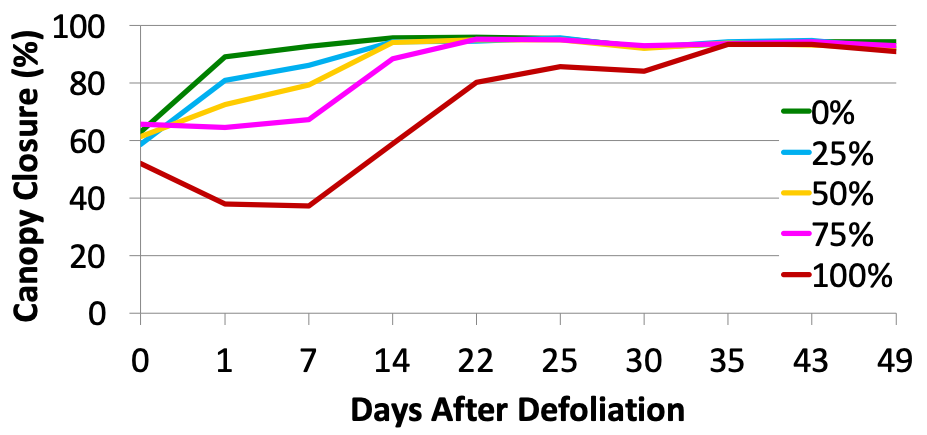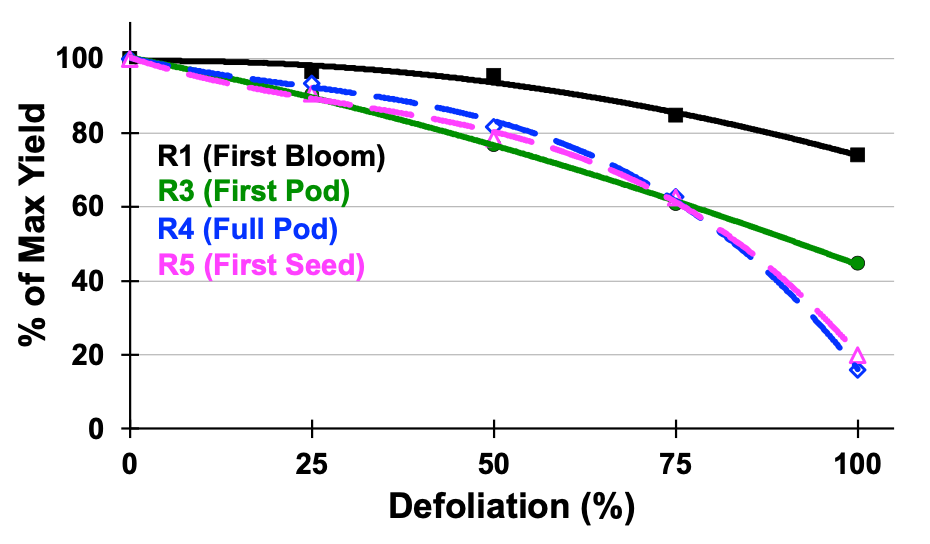Our soybeans have been off to a great start in terms of development this season with 30% of Indiana flowering as of July 7th (USDA-NASS, 2024). This flowering progress aligns with the 5-year average and it is much faster than 2023 (though it was a delayed flowering season). We also have 9% of Indiana that is podding as of July 7th, which is about 7 to 10 days earlier than the 5-year average and 2023. My goal is to have soybeans green to the eye by the 4th of July (e.g., close the row by the time soybean are flowering out the top), but what happens when storms take those leaves away.
Severe weather continues to impact our soybean fields with localized intensity from heavy rains to strong winds to hail. Nothing is more gut-wrenching than to walk out into a field that had great potential the previous day to see leaves, branches, and even pods on the ground. Soybeans have an amazing ability to adapt and overcome many stressful situations from low plant stands in June to leaf loss in July.
How much can soybeans recover? How much yield loss is expected? The answers to these questions will primarily depend on the growth stage that was impacted and the level of damage.
We simulated leaf loss from strong storms and hail for three seasons at R1 (first bloom) and R3 (first pod) on two varieties (maturity 2.7 vs. 3.7). We removed 0, 25, 50, 75, and 100% of the leaves within each one of the varieties as they reached the target growth stage. We took weekly pictures to document the canopy recovery period (Figures 1, 2, 3, and 4) and of course, yield. We followed up with three more seasons of simulations at R4 (full pod) and R5 (first seed).
Canopy closure is not the same as total leaf area or leaf biomass, but it does give us a good idea of plant recovery. Soybeans that lost leaves at R1 took ~2 weeks to recover from 25% and 50% leaf loss, ~3 weeks to recover from 75% leaf loss, and ~5 weeks to recover from 100% leaf loss (Figure 5). As we pushed the leaf loss back until R3, full canopy recovery of soybean with 100% leaf loss did not occur. Interestingly, soybeans canopy recovery after 25 to 75% leaf losses at R3 was better than expected.

Figure 1. Soybean recovery 2, 7, 16, and 23 days after 50% of leaves were removed at R1 (first bloom) in 2014 West Lafayette.

Figure 2. Soybean recovery 2, 7, 16, and 23 days after 100% of leaves were removed at R1 (first bloom) in 2014 West Lafayette.

Figure 3. Soybean recovery 1, 8, 18, and 25 days after 50% of leaves were removed at R3 (first pod) in 2014 West Lafayette.

Figure 4. Soybean recovery 1, 8, 18, and 25 days after 100% of leaves were removed at R3 (first pod) in 2014 West Lafayette.

Figure 5. Canopy closure (%) of soybean (2.7 maturity) that was defoliated at R1 (first bloom) in 2012 West Lafayette.
Soybean yield response to leaf defoliation was similar between the varieties even though they were a full maturity unit different (e.g., 2.7 vs. 3.7). The least amount of yield loss occurred when soybean lost leaves at R1 compared to R3, R4, and R5. With one-fourth to half loss of leaves at R1, soybean yield was still ~95% of maximum potential (Figure 6). Greater leaf loss at R1 still yielded 75 to 80% of its potential.
Interestingly, leaf removal at R3, R4, and R5 demonstrated similar yield potential when 25 to 75% of the leaves were removed (Figure 6). Soybeans reached ~80% of yield potential when half of the leaves were removed and ~60% of yield potential when three-fourths of the leaves were removed R3, R4, or R5.
Soybeans normally continue developing new leaves between R5 to R6 (first seed to full seed) at which point plants shift the priorities to developing pods and seeds. As you might imagine, leaf loss later in reproductive stages or greater leaf loss at R4 and R5 will have more impact on development and yield. These plants have more investment into developing pods and seed, and now, less time for leaf recovery, pod retention, and seed fill before the season closes. This is demonstrated with the yield differences when all the leaves were removed at R3 compared to R4 and R5 (Figure 6).
Weather happens and there is nothing we can do about it. The best course of action is to know the growth stage when the damaged occurred and assess leaf loss (e.g., percent or number of leaflets missing) to get an idea of the yield potential. Even with half of the leaves lost between R1 to R5, soybeans can attain 95 to 80% yield potential.



